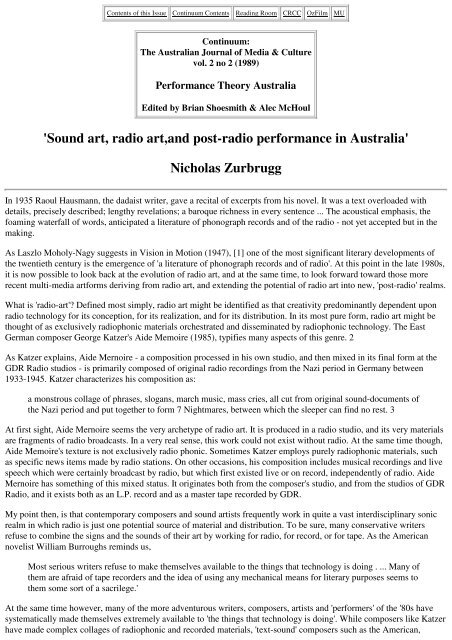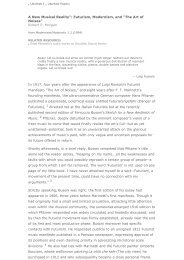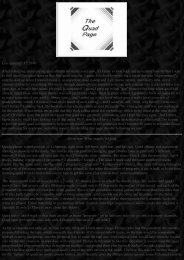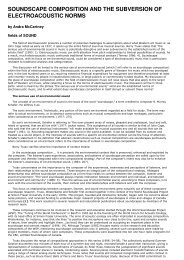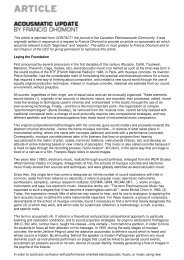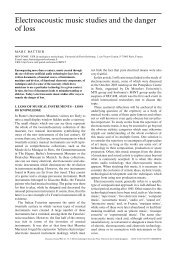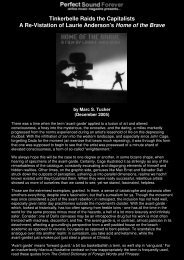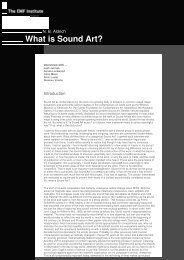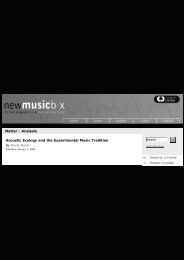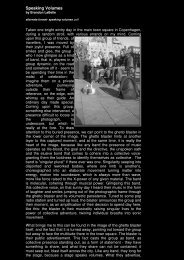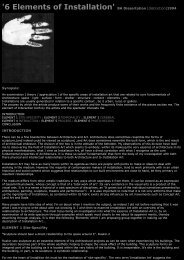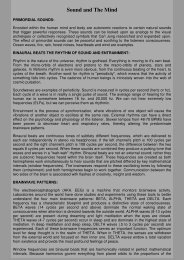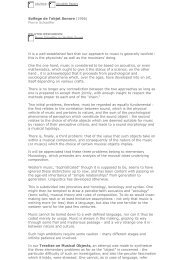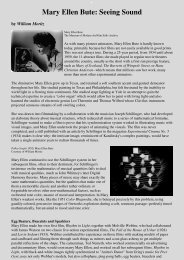'Sound art, radio art,and post-radio performance in Australia ...
'Sound art, radio art,and post-radio performance in Australia ...
'Sound art, radio art,and post-radio performance in Australia ...
You also want an ePaper? Increase the reach of your titles
YUMPU automatically turns print PDFs into web optimized ePapers that Google loves.
Contents of this Issue Cont<strong>in</strong>uum Contents Read<strong>in</strong>g Room CRCC OzFilm MU<br />
Cont<strong>in</strong>uum:<br />
The <strong>Australia</strong>n Journal of Media & Culture<br />
vol. 2 no 2 (1989)<br />
Performance Theory <strong>Australia</strong><br />
Edited by Brian Shoesmith & Alec McHoul<br />
<strong>'Sound</strong> <strong>art</strong>, <strong>radio</strong> <strong>art</strong>,<strong>and</strong> <strong>post</strong>-<strong>radio</strong> <strong>performance</strong> <strong>in</strong> <strong>Australia</strong>'<br />
Nicholas Zurbrugg<br />
In 1935 Raoul Hausmann, the dadaist writer, gave a recital of excerpts from his novel. It was a text overloaded with<br />
details, precisely described; lengthy revelations; a baroque richness <strong>in</strong> every sentence ... The acoustical emphasis, the<br />
foam<strong>in</strong>g waterfall of words, anticipated a literature of phonograph records <strong>and</strong> of the <strong>radio</strong> - not yet accepted but <strong>in</strong> the<br />
mak<strong>in</strong>g.<br />
As Laszlo Moholy-Nagy suggests <strong>in</strong> Vision <strong>in</strong> Motion (1947), [1] one of the most significant literary developments of<br />
the twentieth century is the emergence of 'a literature of phonograph records <strong>and</strong> of <strong>radio</strong>'. At this po<strong>in</strong>t <strong>in</strong> the late 1980s,<br />
it is now possible to look back at the evolution of <strong>radio</strong> <strong>art</strong>, <strong>and</strong> at the same time, to look forward toward those more<br />
recent multi-media <strong>art</strong>forms deriv<strong>in</strong>g from <strong>radio</strong> <strong>art</strong>, <strong>and</strong> extend<strong>in</strong>g the potential of <strong>radio</strong> <strong>art</strong> <strong>in</strong>to new, '<strong>post</strong>-<strong>radio</strong>' realms.<br />
What is '<strong>radio</strong>-<strong>art</strong>'? Def<strong>in</strong>ed most simply, <strong>radio</strong> <strong>art</strong> might be identified as that creativity predom<strong>in</strong>antly dependent upon<br />
<strong>radio</strong> technology for its conception, for its realization, <strong>and</strong> for its distribution. In its most pure form, <strong>radio</strong> <strong>art</strong> might be<br />
thought of as exclusively <strong>radio</strong>phonic materials orchestrated <strong>and</strong> dissem<strong>in</strong>ated by <strong>radio</strong>phonic technology. The East<br />
German composer George Katzer's Aide Memoire (1985), typifies many aspects of this genre. 2<br />
As Katzer expla<strong>in</strong>s, Aide Mernoire - a composition processed <strong>in</strong> his own studio, <strong>and</strong> then mixed <strong>in</strong> its f<strong>in</strong>al form at the<br />
GDR Radio studios - is primarily composed of orig<strong>in</strong>al <strong>radio</strong> record<strong>in</strong>gs from the Nazi period <strong>in</strong> Germany between<br />
1933-1945. Katzer characterizes his composition as:<br />
a monstrous collage of phrases, slogans, march music, mass cries, all cut from orig<strong>in</strong>al sound-documents of<br />
the Nazi period <strong>and</strong> put together to form 7 Nightmares, between which the sleeper can f<strong>in</strong>d no rest. 3<br />
At first sight, Aide Mernoire seems the very archetype of <strong>radio</strong> <strong>art</strong>. It is produced <strong>in</strong> a <strong>radio</strong> studio, <strong>and</strong> its very materials<br />
are fragments of <strong>radio</strong> broadcasts. In a very real sense, this work could not exist without <strong>radio</strong>. At the same time though,<br />
Aide Memoire's texture is not exclusively <strong>radio</strong> phonic. Sometimes Katzer employs purely <strong>radio</strong>phonic materials, such<br />
as specific news items made by <strong>radio</strong> stations. On other occasions, his composition <strong>in</strong>cludes musical record<strong>in</strong>gs <strong>and</strong> live<br />
speech which were certa<strong>in</strong>ly broadcast by <strong>radio</strong>, but which first existed live or on record, <strong>in</strong>dependently of <strong>radio</strong>. Aide<br />
Mernoire has someth<strong>in</strong>g of this mixed status. It orig<strong>in</strong>ates both from the composer's studio, <strong>and</strong> from the studios of GDR<br />
Radio, <strong>and</strong> it exists both as an L.P. record <strong>and</strong> as a master tape recorded by GDR.<br />
My po<strong>in</strong>t then, is that contemporary composers <strong>and</strong> sound <strong>art</strong>ists frequently work <strong>in</strong> quite a vast <strong>in</strong>terdiscipl<strong>in</strong>ary sonic<br />
realm <strong>in</strong> which <strong>radio</strong> is just one potential source of material <strong>and</strong> distribution. To be sure, many conservative writers<br />
refuse to comb<strong>in</strong>e the signs <strong>and</strong> the sounds of their <strong>art</strong> by work<strong>in</strong>g for <strong>radio</strong>, for record, or for tape. As the American<br />
novelist William Burroughs rem<strong>in</strong>ds us,<br />
Most serious writers refuse to make themselves available to the th<strong>in</strong>gs that technology is do<strong>in</strong>g . ... Many of<br />
them are afraid of tape recorders <strong>and</strong> the idea of us<strong>in</strong>g any mechanical means for literary purposes seems to<br />
them some sort of a sacrilege.'<br />
At the same time however, many of the more adventurous writers, composers, <strong>art</strong>ists <strong>and</strong> 'performers' of the '80s have<br />
systematically made themselves extremely available to 'the th<strong>in</strong>gs that technology is do<strong>in</strong>g'. While composers like Katzer<br />
have made complex collages of <strong>radio</strong>phonic <strong>and</strong> recorded materials, 'text-sound' composers such as the American,
Charles Amirkhanian, have turned to television for their <strong>in</strong>spiration, re cord<strong>in</strong>g <strong>and</strong> re-record<strong>in</strong>g its sound-tracks <strong>in</strong> new<br />
p<strong>art</strong>ially musical, p<strong>art</strong>ially literary, compositions for tape, records, <strong>and</strong> <strong>radio</strong>. Amirkhanian's composition Metropolis,<br />
San Francisco re-orchestrates the soundtracks of a Ch<strong>in</strong>ese television program broadcast <strong>in</strong> San Francisco, [5]<br />
transform<strong>in</strong>g this raw material <strong>in</strong>to someth<strong>in</strong>g which might well be broadcast by <strong>radio</strong> as '<strong>radio</strong> <strong>art</strong>'; which might appear<br />
on record or tape as 'sound poetry', 'audio <strong>art</strong>' or environmental 'soundscape'; or which might contribute to certa<strong>in</strong> modes<br />
of p<strong>art</strong>ially live, p<strong>art</strong>ially pre-recorded '<strong>performance</strong> <strong>art</strong>'.<br />
Given these differ<strong>in</strong>g creative <strong>and</strong> critical categories, it seems possible to conceive of <strong>radio</strong> <strong>art</strong> both as a pure <strong>art</strong>, or as<br />
p<strong>art</strong> of a grow<strong>in</strong>g range of multi-media, hybrid <strong>art</strong>-forms. Three primary categories of 'sound' creativity come to m<strong>in</strong>d.<br />
First, as a 'pre-<strong>radio</strong>phonic' genre, sound-<strong>art</strong> created <strong>in</strong> real time comb<strong>in</strong>es sound, music, speech, <strong>and</strong> image, colour <strong>and</strong><br />
gesture. Second, as a 'purely <strong>radio</strong>phonic' genre, created <strong>in</strong> studio time, sound <strong>art</strong> orchestrates sound, music <strong>and</strong> speech <strong>in</strong><br />
an <strong>art</strong> exclusively for the ears. Thirdly, as a hybrid, '<strong>post</strong>-<strong>radio</strong>phonic' genre, sound <strong>art</strong> comb<strong>in</strong>es sound, music, speech,<br />
<strong>and</strong> image, colour <strong>and</strong> gesture <strong>in</strong> both real time <strong>and</strong> studio time <strong>in</strong> variously technological broadcasts, <strong>in</strong>stallations <strong>and</strong><br />
<strong>performance</strong>s. The differ<strong>in</strong>g sub-categories of these three genres may perhaps best be represented <strong>in</strong> the diagram on the<br />
follow<strong>in</strong>g page.<br />
The most significant developments with<strong>in</strong> the contemporary multi media creativity that one might associate with <strong>radio</strong><br />
<strong>art</strong> seem to be the ways <strong>in</strong> which <strong>in</strong>novations elaborated technologically, <strong>in</strong> 'studio time', become p<strong>art</strong> of new modes of<br />
p<strong>art</strong>ially technological <strong>and</strong> p<strong>art</strong>ially live <strong>performance</strong> <strong>in</strong> 'real time'. In this respect, the present seems characterized by<br />
hybrid modes of '<strong>post</strong>-<strong>radio</strong>phonic' creativity, such as video <strong>and</strong> television <strong>art</strong>; video <strong>in</strong>stallations <strong>in</strong>volv<strong>in</strong>g spectator<br />
p<strong>art</strong>icipation; audio <strong>in</strong>stallations <strong>in</strong>volv<strong>in</strong>g spectator p<strong>art</strong>icipation or movement; <strong>and</strong> the synthesis of video <strong>and</strong> audio<br />
<strong>in</strong>stallations <strong>in</strong> complex, live, multi-media <strong>in</strong>stallations.<br />
At the same time, live <strong>performance</strong>, <strong>in</strong> real time, frequently atta<strong>in</strong>s considerable sophistication <strong>and</strong> conceptual<br />
transformation. Such, at least, is the general trend <strong>in</strong> <strong>Australia</strong>. While most <strong>Australia</strong>n <strong>art</strong>ists work<strong>in</strong>g with<strong>in</strong> the general<br />
realms of sound <strong>art</strong> <strong>and</strong> audio <strong>art</strong> are fully aware of the creative potential of the new <strong>post</strong>-modern technologies, they<br />
often elect to work with live <strong>performance</strong> <strong>in</strong> 'real time'. Such work is perhaps best characterised as the exploration of new<br />
k<strong>in</strong>ds of heightened narrative, or the attempt to tell stories <strong>in</strong> a new dynamic, live real-time rhetoric, <strong>in</strong>fluenced by earlier<br />
technological, studio time, experimentation.<br />
As these remarks might suggest, it is difficult to locate many <strong>Australia</strong>n examples of 'pure' <strong>radio</strong>phonic creativity.<br />
Nevertheless, the <strong>in</strong>fluence of <strong>radio</strong> has been quite crucial to the development of the new k<strong>in</strong>ds of heightened, real-time<br />
sonic <strong>performance</strong> presently explored <strong>in</strong> <strong>Australia</strong>. Radio's general impact falls <strong>in</strong>to three ma<strong>in</strong> categories:<br />
(i) as a source of technological mass communication<br />
(ii) as a source of technological <strong>in</strong>novation <strong>and</strong> creation<br />
(iii) as a source of conceptual revolution
In the first <strong>in</strong>stance, as a source of mass communication, <strong>radio</strong> obviously makes exist<strong>in</strong>g sound <strong>art</strong> more accessible. Live<br />
<strong>performance</strong>s from Sydney, for example, become available to listeners throughout <strong>Australia</strong>. Secondly, as a source of<br />
technological creativity, <strong>radio</strong> enables <strong>art</strong>ists to extend their work <strong>in</strong> new ways, either <strong>in</strong>dividually or collectively. New<br />
modes of critical discussion (such as <strong>radio</strong>phonic panels with speakers from several cities) similarly come <strong>in</strong>to be<strong>in</strong>g. In<br />
its third mode, as a source of conceptual revolution, <strong>radio</strong> <strong>and</strong> other forms of studio-based creativity precipitate new<br />
<strong>art</strong>istic aspirations with<strong>in</strong> real-time <strong>performance</strong>, <strong>and</strong> prompt new modes of live <strong>art</strong> based upon practices first made<br />
possible by record<strong>in</strong>g <strong>and</strong> broadcast<strong>in</strong>g technology.<br />
The A.B.C. program Surface Tension, broadcast every Saturday after noon until its recent demise, consistently<br />
documented new forms of <strong>Australia</strong>n <strong>and</strong> <strong>in</strong>ternational sound <strong>art</strong>. A typical program played record<strong>in</strong>gs of a Swiss alp<strong>in</strong>e<br />
horn, from the studios of French <strong>radio</strong>, <strong>and</strong> record<strong>in</strong>gs document<strong>in</strong>g live 'sound <strong>art</strong>' <strong>performance</strong>s from the Performance<br />
Space gallery <strong>in</strong> Sydney. One of the most <strong>in</strong>terest<strong>in</strong>g of these <strong>performance</strong>s was a narrative entitled Terrier by Allan<br />
Vizents, a 'new <strong>Australia</strong>n' born <strong>in</strong> California, who first worked with the Perth collective Media Space (comb<strong>in</strong><strong>in</strong>g<br />
photographic, graphic, recorded <strong>and</strong> written work), <strong>and</strong> then moved to Sydney, where he directed Performance Space<br />
until his untimely death <strong>in</strong> 1987. Vizents' poem Terrier typifies his extremely imag<strong>in</strong>ative mature narrative<br />
<strong>performance</strong>s, <strong>and</strong> <strong>in</strong> the process, offers memorable verbal realization to Franz Marc's aspiration to 'pa<strong>in</strong>t the existence<br />
of a dog as Picasso pa<strong>in</strong>ts the existence of a cubic shape'. 6<br />
Vizents achieves this evocation of the feel<strong>in</strong>gs <strong>and</strong> thoughts of a dog by comb<strong>in</strong><strong>in</strong>g two levels of narrative. At its most<br />
fanciful, semantic level, his poem dramatizes the mus<strong>in</strong>gs of a terrier, <strong>in</strong> a poetic variant of the k<strong>in</strong>d of fictional 'magic<br />
realism' elaborated by Garcia Marquez <strong>and</strong> Gunter Grass. At its most literal, mimetic level, Vizents' <strong>performance</strong><br />
counterpo<strong>in</strong>ts <strong>and</strong> punctuates this text with a record<strong>in</strong>g of a dog pant<strong>in</strong>g (creat<strong>in</strong>g someth<strong>in</strong>g of the same effect explored<br />
by Beckett <strong>in</strong> his play That Time, <strong>in</strong> which the three narratives of his protagonist are similarly counterpo<strong>in</strong>ted by the<br />
sound of 'audible, slow <strong>and</strong> regular' breath). [7] Commenc<strong>in</strong>g with the marvellously direct assertion: I'm a dog so I bark',<br />
this narrative beg<strong>in</strong>s:<br />
I'm a dog so I bark. I can bite you bet, sure, bite <strong>and</strong> shake. I like the chair by the w<strong>in</strong>dow <strong>in</strong> the afternoon. I<br />
lay there <strong>and</strong> look at the lace patterns on the w<strong>in</strong>dow. It goes straight <strong>in</strong>, circles <strong>and</strong> stars <strong>in</strong>side. There is a<br />
tear <strong>in</strong> the flyscreen. I don't m<strong>in</strong>d that either. The chair is smelly, my chair, dog chair. When a cloud passes
y, I open one eye <strong>and</strong> feel the cool change go straight <strong>in</strong>.<br />
I am a spy, be<strong>in</strong>g spy is dogness ... [8]<br />
One has to imag<strong>in</strong>e the sound of a pant<strong>in</strong>g dog between the conclusion of the poem's first section (with the words 'go<br />
straight <strong>in</strong>'), <strong>and</strong> the beg<strong>in</strong>n<strong>in</strong>g of its subsequent section (with the announcement I am a spy'). One also has to imag<strong>in</strong>e<br />
the strange conjunction of Vizents' Californian <strong>in</strong>tonation, assert<strong>in</strong>g 'I'm a dog', <strong>and</strong> his poem's subtle del<strong>in</strong>eation of the<br />
details of <strong>Australia</strong>n suburban existence: the <strong>in</strong>convenience of 'a tear <strong>in</strong> the flyscreen', <strong>and</strong> the welcome relief offered by<br />
the breeze, as one senses a 'cool change'. Vizents' Terrier typifies what one might th<strong>in</strong>k of as '<strong>post</strong>-<strong>radio</strong>phonic' work,<br />
offer<strong>in</strong>g a highly <strong>in</strong>dividual synthesis of live <strong>and</strong> recorded narrative <strong>in</strong> a fusion of real time <strong>and</strong> studio time, generated by<br />
sound, speech <strong>and</strong> gesture.<br />
Significantly, Vizents' mature work derives from a succession of earlier technological experiments documented upon the<br />
audio-cassettes distributed by the Media-Space group, such as 'sound-draw<strong>in</strong>gs', made by mov<strong>in</strong>g a microphone around<br />
objects of furniture;9 collective verbal <strong>and</strong> <strong>in</strong>strumental improvisations; 10 <strong>and</strong> relatively simple permutational poems<br />
rem<strong>in</strong>iscent of Brion Gys<strong>in</strong>'s pioneer<strong>in</strong>g work <strong>in</strong> this genre. 11 Like many of the sound <strong>art</strong>ists <strong>in</strong> <strong>Australia</strong>, Vizents<br />
<strong>in</strong>itially seems to have explored the potential of his creativity <strong>in</strong> relative isolation. Indeed, at one of the first substantial<br />
festivals of <strong>Australia</strong>n audio <strong>art</strong>, held at the ANZART exhibition <strong>in</strong> Hob<strong>art</strong>, <strong>in</strong> 1983, [l2] Vizents admitted that he had<br />
never previously presented his work <strong>in</strong> public <strong>in</strong> live <strong>performance</strong>, <strong>and</strong> had only distributed it <strong>in</strong> cassette form.<br />
In the follow<strong>in</strong>g years, Vizents developed his own extremely <strong>in</strong>dividual - <strong>and</strong> extremely sophisticated - <strong>performance</strong><br />
style, until he f<strong>in</strong>ally reached the po<strong>in</strong>t at which he preferred to m<strong>in</strong>imize the technological accompaniment <strong>and</strong><br />
equipment that had <strong>in</strong>itially given birth to the verbal distortions <strong>in</strong> his poetry. In the course of an <strong>in</strong>terview of 1984,<br />
shortly before a <strong>performance</strong> of his work, Vizents characteristically remarked:<br />
I've performed with pre-recorded tapes, but over the past few months I've gradually elim<strong>in</strong>ated them. In fact<br />
I've tried to get the sound system turned down to the barest m<strong>in</strong>imum tonight so there won't be so much<br />
<strong>in</strong>terference with the quality of voice. 13<br />
Some two years later, at the beg<strong>in</strong>n<strong>in</strong>g of one of his last read<strong>in</strong>gs, Vizents triumphantly <strong>in</strong>formed his audience that his<br />
technological equipment was not work<strong>in</strong>g, add<strong>in</strong>g that this was not really a serious problem, s<strong>in</strong>ce his <strong>performance</strong>s did<br />
not really depend upon the technological accompaniment of the pre-recorded tapes with which he had planned to<br />
counterpo<strong>in</strong>t <strong>and</strong>, as it were, exp<strong>and</strong> <strong>and</strong> extend his work. As a <strong>radio</strong> broadcast of one of his subsequent <strong>performance</strong>s<br />
demonstrated, Vizents' use of pre-re corded tapes <strong>and</strong> live declamation generated beautifully orchestrated comic<br />
monologues, <strong>in</strong> which the pre-recorded tape added supplementary comments - almost footnotes - to Vizents' primary,<br />
real-time, declamation.<br />
But as Vizents' mature <strong>performance</strong>s demonstrated, his work had reached the po<strong>in</strong>t at which meticulously timed, live<br />
improvisation virtually eclipsed the impact of pre-recorded montage. While his real-time <strong>performance</strong> lacked the<br />
quantitative advantage of multi-layered narrative, its 'quality of voice' (to quote Vizents' phrase), atta<strong>in</strong>ed a remarkable<br />
sonic virtuosity, with all the excitement <strong>and</strong> surprise of live, spontaneous theatricality, '<strong>in</strong>vent<strong>in</strong>g words <strong>and</strong> muck<strong>in</strong>g the<br />
language up, <strong>in</strong> a sense, so that it doesn't follow the strict rules of grammar'. 14<br />
At its most coherent extreme, Vizents' experiments with grammar lead to highly amus<strong>in</strong>g colloquial narratives, full of<br />
impatient repetitions <strong>and</strong> abbreviations, such as I'm Busy a wonderful satire of the <strong>Australia</strong>n suburban ritual of lov<strong>in</strong>gly<br />
repair<strong>in</strong>g decrepit automobiles. Commenc<strong>in</strong>g with another of Vizents' splendidly abrupt assertions, this poem announces:<br />
I'm go<strong>in</strong>g to expla<strong>in</strong> this real simple, I'm busy. I'm really busy with this car here, I'm dirty, greasy, grease<br />
under the f<strong>in</strong>gernails, greasy h<strong>and</strong>s, greasy pants, greasy shoes, <strong>and</strong> I can't come <strong>in</strong> the house right now, <strong>and</strong><br />
I can't answer the phone cause I'm busy <strong>and</strong> I won't be answer<strong>in</strong>g the phone when any granny calls or any<br />
mum or dad or Dave, that k<strong>in</strong>d of stuff, cause I'm busy ...' 5<br />
At its least coherent extreme, Vizents' work ab<strong>and</strong>ons normal language, <strong>and</strong> enters a realm of frantic nonsensical<br />
improvisation, such as the follow<strong>in</strong>g l<strong>in</strong>es from Fill It: a poem satiris<strong>in</strong>g the adm<strong>in</strong>istrative conventions requir<strong>in</strong>g one to<br />
fill forms up <strong>in</strong> triplicate. l6 Rapidly escalat<strong>in</strong>g <strong>in</strong>to absurd abstraction, the first six l<strong>in</strong>es of this poem propose:<br />
Fill it out <strong>in</strong> triplicate would'ya?<br />
Fill it out <strong>in</strong> triplicate would'ya?<br />
Fillit out <strong>in</strong> triplicate would'ya?<br />
Fill it up <strong>in</strong> triple it wichya?
Fill it up en tripleit wichya?<br />
Fill erup en tipleit wichya?<br />
Last year, I formed a 'b<strong>and</strong>' with another technician at San Jose State ... <strong>and</strong> we did a concert of<br />
By l<strong>in</strong>e n<strong>in</strong>e, the poem's <strong>in</strong>itial imperative transmutes <strong>in</strong>to the bizarre request: 'Fositup <strong>in</strong> tripple whenchya?, while l<strong>in</strong>es<br />
fourteen <strong>and</strong> fifteen contort this phrase <strong>in</strong>to the still stranger supplication:<br />
Fillit upside over <strong>in</strong> tripple tripple tripple<br />
Woutjah?<br />
Such permutations are not new, but the virtuosity of Vizents' <strong>in</strong>tonation <strong>and</strong> the precision of his tim<strong>in</strong>g are extremely<br />
unusual, as George Katzer remarked, while discuss<strong>in</strong>g a record<strong>in</strong>g of this poem at the Graz Radiokunst symposium-l7<br />
Vizents' masterly mature <strong>performance</strong>s seem the consequence of two ma<strong>in</strong> <strong>in</strong>fluences: his own earlier creative<br />
experiments <strong>in</strong> the record<strong>in</strong>g studio, <strong>and</strong> the more general, conceptual impact of exposure to the work of other <strong>art</strong>ists at<br />
festivals, on records <strong>and</strong> tapes, <strong>and</strong> via <strong>radio</strong> programs such as Surface Tension. Whereas European <strong>and</strong> American sound<br />
poetry <strong>and</strong> <strong>performance</strong> frequently tend towards abstraction <strong>and</strong> a certa<strong>in</strong> universal quality, Vizents' texts typify the<br />
relatively specific, satirical impulse <strong>in</strong> a great deal of <strong>Australia</strong>n sound <strong>art</strong>.<br />
The general consequence of this humorous, satirical impulse <strong>in</strong> <strong>Australia</strong>n sound <strong>art</strong> is its surpris<strong>in</strong>gly accessible public<br />
quality. One of the greatest problems for most <strong>Australia</strong>n poets is the <strong>in</strong>itial task of success fully <strong>in</strong>troduc<strong>in</strong>g <strong>in</strong>novative<br />
sound <strong>art</strong> <strong>and</strong> <strong>performance</strong> to a wider audience than their immediate circle of friends. The gradual development <strong>and</strong><br />
acceptance of <strong>Australia</strong>n sound <strong>art</strong> seems to follow a fairly predictable series of <strong>in</strong>itiatives:<br />
- live read<strong>in</strong>gs<br />
- taped work<br />
- taped anthologies<br />
- festivals <strong>and</strong> critical forums<br />
- <strong>radio</strong> documentation of festivals on public or subscriber stations<br />
- <strong>radio</strong> features on <strong>in</strong>dividual <strong>art</strong>ists<br />
- video documentation on <strong>in</strong>dividual <strong>art</strong>ists<br />
The existence of both public <strong>radio</strong> stations, <strong>and</strong> alternative, subscriber stations, offers two dist<strong>in</strong>ct k<strong>in</strong>ds of <strong>radio</strong><br />
broadcast<strong>in</strong>g. On the one h<strong>and</strong>, the <strong>Australia</strong>n Broadcast<strong>in</strong>g Corporation's national <strong>radio</strong> programs have occasionally<br />
given substantial attention to <strong>in</strong>dividual poets, <strong>and</strong> <strong>in</strong> programs such as Surface Tension <strong>and</strong> its successor, The Listen<strong>in</strong>g<br />
Room, the A.B.C. has offered listeners a wide array of national <strong>and</strong> <strong>in</strong>ternational variants of sound <strong>art</strong> <strong>and</strong> <strong>radio</strong> <strong>art</strong>. On<br />
the other h<strong>and</strong>, subscriber <strong>radio</strong>s, such as Brisbane's 4ZZZ, have <strong>in</strong>creas<strong>in</strong>gly supplemented their usual selection of rock<br />
<strong>and</strong> new wave music with examples of different k<strong>in</strong>ds of sonic <strong>and</strong> verbal <strong>performance</strong>, p<strong>art</strong>icularly the work collected<br />
on the many L.P. anthologies published by the New York poet, John Giorno. 18 Gradually, then, through live read<strong>in</strong>gs,<br />
rare tape cassettes, occasional multi media festivals, <strong>and</strong> a variety of <strong>radio</strong> programs, sound <strong>art</strong> has become <strong>in</strong>creas<strong>in</strong>gly<br />
familiar to <strong>Australia</strong>n audiences.<br />
As the Californian poet, Larry Wendt, acknowledges <strong>in</strong> a recent letter of December l988, purist concepts of sound <strong>art</strong> or<br />
of <strong>radio</strong> <strong>art</strong> seem very much a th<strong>in</strong>g of the past. 19<br />
Sound poetry has perhaps died out as a specific area of work<strong>in</strong>g or perhaps it's not called that any more by<br />
new people work<strong>in</strong>g <strong>in</strong> that area.<br />
Yet as Wendt very significantly adds, if the concepts of <strong>radio</strong> <strong>art</strong>, of sound <strong>art</strong> or of sound poetry now seem a little<br />
old-fashioned, the different practices designated by these terms are still remarkably healthy:<br />
Actually, there is probably more electro-acoustic literature <strong>and</strong> language <strong>art</strong> be<strong>in</strong>g done now than ever<br />
before. It's often just called someth<strong>in</strong>g else. One doesn't hear the words 'sound poet' as much, or even less<br />
'text-sound composer' any more - only us die-hards still speak <strong>in</strong> those terms.<br />
F<strong>in</strong>ally, discuss<strong>in</strong>g his own work <strong>in</strong> the field, Wendt relates:
'<strong>post</strong>-<strong>in</strong>dustrial music' ... The campus <strong>radio</strong> station went nuts over it <strong>and</strong> will play anyth<strong>in</strong>g now that we give<br />
them over the <strong>radio</strong> ...1 always thought that one had to die to Ra<strong>in</strong> that k<strong>in</strong>d of recognition. All that I needed<br />
to do was call it by a different name as some k<strong>in</strong>d of experimental rock 'n' roll ... These are strange days<br />
<strong>in</strong>deed.<br />
Wendt's letter very <strong>in</strong>terest<strong>in</strong>gly testifies to the ways <strong>in</strong> which popular forms of <strong>radio</strong> broadcast<strong>in</strong>g - <strong>in</strong> this <strong>in</strong>stance, a<br />
university rock 'n' roll station - have both re-def<strong>in</strong>ed certa<strong>in</strong> experimental <strong>art</strong> practices, <strong>and</strong> ex tended their audiences, by<br />
associat<strong>in</strong>g them with more accessible categories, such as '<strong>post</strong>-<strong>in</strong>dustrial' music. In someth<strong>in</strong>g of the same way, concepts<br />
like 'sound sculpture', 'sound <strong>in</strong>stallations' <strong>and</strong> 'video <strong>in</strong>stallations' have allowed different k<strong>in</strong>ds of 'sound <strong>art</strong>' to f<strong>in</strong>d more<br />
widespread exhibition, <strong>and</strong> more significantly still, to be created for more widespread exhibition. Significantly, Ed<br />
Tomney, an American composer who also contributed a work to the Graz Radiokunst festival, describes his exhibit at the<br />
festival - a piece entitled Whisper<strong>in</strong>g Elms - <strong>in</strong> terms of its flexible format <strong>in</strong> time <strong>and</strong> space. Discuss<strong>in</strong>g this work <strong>in</strong> a<br />
letter of October l988, Tomney writes:<br />
The piece is a work-<strong>in</strong>-progress, mean<strong>in</strong>g it can be subject to changes <strong>and</strong> additions through two means.<br />
First, as a multi-track record<strong>in</strong>g, voices <strong>and</strong> sounds can be added to the pre-exist<strong>in</strong>g first hour, so that<br />
group<strong>in</strong>gs of sounds can be made dense or sparse. Second, new material can be added to the first hour, so<br />
that the piece exp<strong>and</strong>s <strong>in</strong> l<strong>in</strong>ear form as new material is added ... The reason<strong>in</strong>g beh<strong>in</strong>d this formula is that<br />
this work is often presented <strong>in</strong> different mediums, <strong>and</strong> is not <strong>in</strong>tended to be any one specific duration of time<br />
... Different sections of the material can be used <strong>in</strong> specific situations. 20<br />
At present, <strong>Australia</strong>n sound work - or at least, sound work by many of the most <strong>in</strong>terest<strong>in</strong>g experimental <strong>Australia</strong>n<br />
poets - neither approximates to rock n' roll, nor to the k<strong>in</strong>d of open-ended technological audio-<strong>in</strong>stallation created by<br />
Tomney. What <strong>Australia</strong>n sound work does do, however, is to explore a range of predom<strong>in</strong>antly narrative genres<br />
modify<strong>in</strong>g <strong>and</strong> satiris<strong>in</strong>g verbal <strong>and</strong> social conventions. Somewhat as Allan Vizents plays with colloquialisms <strong>and</strong><br />
cliches of adm<strong>in</strong>istrative jargon, the Melbourne poet <strong>and</strong> composer Chris Mann wages war on received diction <strong>and</strong><br />
grammar p<strong>art</strong>icularly English diction <strong>and</strong> grammar - <strong>in</strong> the attempt to generate an authentically <strong>Australia</strong>n discourse.<br />
Language, then, is very much Chris Mann's primary concern, p<strong>art</strong>icularly the social <strong>and</strong> the ideological consequences of<br />
different verbal conventions. Whereas Larry Wendt's work may lend itself to redef<strong>in</strong>ition <strong>in</strong> terms of music, <strong>and</strong> whereas<br />
Ed Tomney's compositions seem to explore the open-ended, variable composition encouraged by Cage, <strong>in</strong>terweav<strong>in</strong>g<br />
sound <strong>and</strong> sense <strong>in</strong> what one might th<strong>in</strong>k of as some sort of sonic 'mobile', Mann's work appears to be hr more committed<br />
to concrete social contexts. Such, at least, is Mann's aspiration. Discuss<strong>in</strong>g his work <strong>in</strong> an <strong>in</strong>terview of 1983, Mann<br />
expla<strong>in</strong>ed:<br />
Yarns, <strong>in</strong>tonation-games, skip-rope songs, jokes, nonsense words ...1 th<strong>in</strong>k that's the tradition that we slot<br />
<strong>in</strong>to. I th<strong>in</strong>k it's a popular culture. I don't th<strong>in</strong>k it's a bourgeois culture. I don't th<strong>in</strong>k it's an <strong>art</strong> culture. There's<br />
a whole tradition p<strong>art</strong>icularly <strong>in</strong> Melbourne ... of deal<strong>in</strong>g with language as an issue. It's like the role of the<br />
Grammarians <strong>in</strong> the French Revolution <strong>and</strong> the role of the Proletcult <strong>in</strong> the Russian Revolution. 2l<br />
Mann tries to deal with language as a popular social issue by <strong>in</strong>vent<strong>in</strong>g, or at least, by ref<strong>in</strong><strong>in</strong>g, a qu<strong>in</strong>tessentially<br />
colloquial form of <strong>Australia</strong>n diction <strong>in</strong> narratives performed at maximum speed. In this way, Mann aspires to evade<br />
English literary traditions, <strong>and</strong> to reveal or revive a more democratic, more authentic, antipodean utterance. Mann's<br />
<strong>performance</strong> often take the form of somewhat whimsical monologues, rather like John Cage's anecdotal lectures. But<br />
whereas Cage's subject matter tends to lead his autobiographical stories towards more general meditations upon the<br />
nature of order, chance, composition <strong>and</strong> <strong>art</strong>, Mann's texts focus upon questions of l<strong>in</strong>guistics <strong>and</strong> philosophy before<br />
break<strong>in</strong>g <strong>in</strong>to idiosyncratic semi-phonetic colloquialisms rem<strong>in</strong>iscent of Joycian wordplay <strong>in</strong> F<strong>in</strong>negan's Wake. The<br />
follow<strong>in</strong>g extract from Mann's monologue commenc<strong>in</strong>g SCRATCH SCRATCH) gives some <strong>in</strong>dication of the <strong>in</strong>ventive<br />
ways <strong>in</strong> which he mixes polemical overstatement with semantic compression <strong>and</strong> distortion. 22<br />
1. CHOMSKY WAS AN EARLY NATO SET UP 2. CREDIT IS DISTRACTION FORMALISED. ALL I<br />
KNOW ABOUT MORGENBESSER IS THE ONE THAT GOES THAT THERE WAS THIS LADY<br />
PHILOSOPHER ADDRESSING A BUNCH OF PHILOSOPHERS ON THE DISTINCTIONS BETWEEN<br />
ARTIFICIAL AND NATURAL LANGUAGES & SHE WAS GOING ON THAT ALL THE<br />
LANGUAGES SHE KNEW - WHETHER ARTIFICIAL OR NATURAL LANGUAGES - THAT IN ALL<br />
THESE LANGUAGES A DOUBLE NEGATIVE ALWAYS MEANS A POSITIVE BUT THAT SHE<br />
KNEW OF NO LANGUAGE EITHER NATURAL OR ARTIFICIAL WHERE A DOUBLE POSITIVE<br />
MEANT ANYTHING BUT A POSITIVE, WHEREUPON MORGENBESSER IS HEARD TO PIPE UP<br />
FROM THE BACK, YEAH YEAH TAKE THE MEAT AND WITH VEGETABLES STUFF IN TH<br />
STOMACH OF MEAT AND BOIL. MILKS ALSO USED. A GENITIVE RIFE LL GIVE YOU WIND OF
JACKETING POTS ALL TOO BLOODY GREEN T STONE BUT I KNEW A BLOKE THAT SWEARS<br />
BEFORE THE WEEL HE PUT A DENT IN THIS HERE DAM & THAT'S WHERE THE HANDLE TO<br />
SWING Y FUCKIN SPIT COME FROM.<br />
Mann's utterance clearly deploys several quite dist<strong>in</strong>ct levels of discourse. On the one h<strong>and</strong>, it exploits cryptic,<br />
epigrammatic witticisms, such as 'Chomsky was an early NATO setup', or 'Credit is distraction formalised'. At a more<br />
coherent level, it employs susta<strong>in</strong>ed anecdote, such as 'the one that goes that there was this lady philosopher'. But as the<br />
conclud<strong>in</strong>g l<strong>in</strong>es of this extract demonstrate, Mann's <strong>performance</strong>s also frequently erupt <strong>in</strong>to abbreviated slang,<br />
colloquialisms <strong>and</strong> obscenities verg<strong>in</strong>g upon quite <strong>in</strong>accessible nonsense language. These experiments have prompted<br />
quite varied responses. Cage, for example, comments: 'I th<strong>in</strong>k of Chris Mann's work as be<strong>in</strong>g fresh <strong>and</strong> a new direction <strong>in</strong><br />
poetry', 23 remark<strong>in</strong>g elsewhere: 1t is very strik<strong>in</strong>g. Congratulations. I would also like to know how you wrote this text.<br />
24<br />
Cage's comments upon the fresh <strong>and</strong> strik<strong>in</strong>g quality of Mann's work obviously emphasize its formal <strong>and</strong> ludic<br />
orig<strong>in</strong>ality. As Allan Vizents similarly comments, <strong>in</strong> an <strong>in</strong>terview of 1986, Mann's texts <strong>and</strong> <strong>performance</strong>s are <strong>in</strong>imitable:<br />
He's ... ref<strong>in</strong>ed a style, an approach, <strong>and</strong> a method of construct<strong>in</strong>g language, that is highly ... idiosyncratic ...<br />
only Chris Mann could have developed that k<strong>in</strong>d of text. 25<br />
But Vizents is also more critical of the ideological implications of Mann's writ<strong>in</strong>g, <strong>in</strong>sofar as Mann claims that he is not<br />
so much creat<strong>in</strong>g <strong>art</strong>, as problematis<strong>in</strong>g language <strong>and</strong> national identity. Vizents disputes, this claim, on the grounds that<br />
there is no obvious or explicit political impact <strong>in</strong> Mann's utterance. One could perceive Mann's work as some sort of<br />
revolutionary demonstration of the desirability of an <strong>Australia</strong>n grammar. But one might equally well consider Mann's<br />
read<strong>in</strong>gs to be highly amus<strong>in</strong>g, highly versatile <strong>and</strong> highly subjective forms of verbal play. Consider<strong>in</strong>g some of these<br />
questions <strong>in</strong> the same <strong>in</strong>terview, Vizents observed:<br />
Is his idiosyncratic language work<strong>in</strong>g? Or is it just enterta<strong>in</strong>ment? Does it carry any mean<strong>in</strong>g beyond that<br />
sense of play ... And on another level, is it reflect<strong>in</strong>g extreme nationalism that says, my language is<br />
p<strong>art</strong>icularly <strong>Australia</strong>n - that's what makes it good, valid, <strong>and</strong> a valid form to work on? ... Sometimes he'll<br />
say <strong>Australia</strong>n grammar reflects a far better or a far more <strong>in</strong>terventionist politic than American grammar. I<br />
wonder if that's right? 26<br />
One detects a certa<strong>in</strong> irony here. Vizents himself has described his work as an attempt to modify conventional grammar,<br />
<strong>and</strong> to generate what he calls 'messed-up grammar' <strong>in</strong> order to 'reveal the ironies <strong>in</strong> the way <strong>in</strong> which we look at the<br />
world <strong>and</strong> the way <strong>in</strong> which we perceive the world'. Like Mann's texts, his work reflects upon the <strong>Australia</strong>n cultural<br />
environment, <strong>and</strong>, as it were, upon the <strong>Australia</strong>n l<strong>in</strong>guistic environment. Unlike Mann, however, Vizents seems happy<br />
to comb<strong>in</strong>e notions of the aesthetic <strong>and</strong> the social, the idiosyncratic <strong>and</strong> the public. While Mann has argued aga<strong>in</strong>st<br />
'private language', 27 Vizents seems far more <strong>in</strong>terested <strong>in</strong> the exploration of the <strong>in</strong>dividual sensibility. Prais<strong>in</strong>g the work<br />
of another Melbourne poet, the Polish-born writer <strong>and</strong> <strong>art</strong>ist Ania Walwicz, Vizents comments:<br />
She puts forward a k<strong>in</strong>d of exploratory-of-her-own-consciousness k<strong>in</strong>d of image. And it seems that she's<br />
committed toward that work<strong>in</strong>g on herself. And I appreciate that. It's tough work. It's hard work. 28<br />
Ania Walwicz describes the evolution of her poetry <strong>and</strong> <strong>performance</strong>s <strong>in</strong> terms of her childhood memories of listen<strong>in</strong>g to<br />
poetry be<strong>in</strong>g read <strong>in</strong> a foreign language:<br />
I suppose my first perception <strong>in</strong> my childhood of poetry was my father who used to know a lot of poetry by<br />
he<strong>art</strong> - a lot of German poetry - <strong>and</strong> he used to say it to me, <strong>and</strong> then he would translate it. So the way I<br />
encountered poetry as such, was just sound <strong>and</strong> also sound <strong>in</strong> a foreign language. 29<br />
Walwicz's own poems have someth<strong>in</strong>g of this mysterious quality. As she expla<strong>in</strong>s, they attempt to register a dream-like<br />
sensibility:<br />
I'm not specially writ<strong>in</strong>g <strong>in</strong> a sort of distorted manner on purpose. It's more the language of the subconscious<br />
thought, or the language of <strong>in</strong>ner th<strong>in</strong>k<strong>in</strong>g, not the conscious literal language.<br />
Like Allan Vizents <strong>and</strong> Chris Mann, Walwicz seems primarily concerned to explore alternatives to conventional<br />
grammar <strong>and</strong> 'conscious literal language'. While the general thematic <strong>and</strong> emotive tone of her work varies considerably<br />
on occasion, rang<strong>in</strong>g from impassioned evocations of re morse to 'sensual perceptions of gratification', 30 Walwicz's<br />
<strong>performance</strong>s are most frequently characterised by a sense of subdued <strong>in</strong>tensity, conveyed without compromise either to<br />
exaggeration or simplification. In other words, whereas certa<strong>in</strong> American <strong>performance</strong> <strong>art</strong>ists, such as Diam<strong>and</strong>a Galas,
have transformed sonic histrionics <strong>in</strong>to an <strong>art</strong>form, while others, such as Laurie Anderson, have captivated audiences<br />
with consciously accessible confessional anecdotes, 3l Walwicz works between these two poles, elucidat<strong>in</strong>g <strong>and</strong><br />
accentuat<strong>in</strong>g the sound value of her text by the modulation of the tonal range of her voice, <strong>and</strong> gestur<strong>in</strong>g towards<br />
emotion <strong>and</strong> confession <strong>in</strong> her own terms, rather than opt<strong>in</strong>g to make them perfectly explicit.<br />
Paradoxically, this k<strong>in</strong>d of seem<strong>in</strong>gly private aesthetic can have surpris<strong>in</strong>gly public impact. Ponder<strong>in</strong>g upon this<br />
possibility with reference to the way <strong>in</strong> which his own poems are 'completely personal, absolutely 100% subjective', the<br />
American poet John Giorno expla<strong>in</strong>s:<br />
When it works, it's like the subjectivity becomes the objectivity. It becomes the subjectivity of the audience,<br />
so it's what the audience wants to hear ... So it's not subjective <strong>in</strong> the sense that it's just me - it's everyone <strong>in</strong><br />
the audience, <strong>and</strong> it becomes completely objective. 32<br />
In much the same way, Ania Walwicz reports that her own highly subjective texts seem to overlap with her readers'<br />
experience, <strong>in</strong> the sense that they provoke the same evocative <strong>in</strong>tonation when read aloud by others. Discuss<strong>in</strong>g a series<br />
of ten 'colour' poems, 'each deal<strong>in</strong>g with a p<strong>art</strong>icular level of feel<strong>in</strong>g or be<strong>in</strong>g', <strong>and</strong> each written to 'enact that p<strong>art</strong>icular<br />
state of feel<strong>in</strong>g with<strong>in</strong> me' <strong>in</strong> terms of a 'p<strong>art</strong>icular form of tone', Walwicz recounts:<br />
I asked other people to read my work to see how it would turn out whether I was just project<strong>in</strong>g the sound<br />
value onto it. I asked them to read it without formally hav<strong>in</strong>g heard it read by me. And <strong>in</strong> actual fact they did<br />
slot <strong>in</strong>to a form of read<strong>in</strong>g which I actually do myself.<br />
The follow<strong>in</strong>g l<strong>in</strong>es from Red - an 'angry' monologue from this series - gives some idea of the p<strong>art</strong>ially private, p<strong>art</strong>ially<br />
public, qualities of these poems:<br />
kill cow hang butcher am angry hot head big ideas stronger know what bloody mary hates me look what fell<br />
over hurt knee what to do bright colour put b<strong>and</strong>age around don't want to see now look bag big th<strong>in</strong>gs kills<br />
wife redhead <strong>in</strong> my house is jealous so jealous tulip is loud apple is ok dwarf is nasty peaked hat knife <strong>in</strong> gut<br />
was murderer eats children ...33<br />
As Ania Walwicz remarked, while p<strong>art</strong>icipat<strong>in</strong>g on a <strong>radio</strong> forum simultaneously recorded <strong>in</strong> Melbourne, Sydney <strong>and</strong><br />
Brisbane, her work encompasses a variety of genres <strong>and</strong> motivations:<br />
Not everyth<strong>in</strong>g I have written was meant to be read . . . But then, of course, I never saw myself <strong>in</strong> any<br />
p<strong>art</strong>icular category, <strong>and</strong> didn't set out to produce complete sound poetry. If that was so, I could put out tapes<br />
<strong>in</strong>stead of writ<strong>in</strong>g it. But <strong>in</strong> my case, I do want the literary p<strong>art</strong> of it to exist, so that people can read it.<br />
Questioned dur<strong>in</strong>g the same forum about the overlap between her literary <strong>and</strong> non-literary work, Walwicz agreed that<br />
both fields explored similar subject matter:<br />
My work <strong>in</strong> the visual <strong>art</strong>s is neo-expressionist, <strong>and</strong> this form of writ<strong>in</strong>g deals with that as well. I'm deal<strong>in</strong>g with that<br />
autobiographical notation <strong>and</strong> enactment of <strong>in</strong>ner feel<strong>in</strong>g <strong>and</strong> be<strong>in</strong>g, <strong>and</strong> <strong>in</strong> my <strong>performance</strong>s I've dealt with the same<br />
aims. So all of my work is under the same head<strong>in</strong>g, us<strong>in</strong>g my own life.<br />
Like most of her fellow sound <strong>art</strong>ists <strong>in</strong> <strong>Australia</strong>, Ania Walwicz's work fluctuates between 'pre-<strong>radio</strong>phonic'<br />
compositions, <strong>radio</strong> <strong>art</strong> <strong>and</strong> '<strong>post</strong> <strong>radio</strong>' <strong>performance</strong>. The latter category is best exemplified by Voices, a piece for 'four<br />
speakers, speak<strong>in</strong>g to one another', presented at the Sound works festival at the 1986 Sydney Biennale. 34<br />
Voices was first recorded <strong>and</strong> orchestrated <strong>in</strong> a record<strong>in</strong>g studio, before tak<strong>in</strong>g its f<strong>in</strong>al shape as a predom<strong>in</strong>antly live<br />
<strong>performance</strong> dur<strong>in</strong>g which Walwicz lies on the stage, listen<strong>in</strong>g to the four voices issu<strong>in</strong>g from the four surround<strong>in</strong>g<br />
speakers. Walwicz expla<strong>in</strong>s:<br />
I wanted to portray an <strong>in</strong>ner state <strong>in</strong> which you heard all these different voices ... In my case it was deal<strong>in</strong>g<br />
with a p<strong>art</strong>icular personal situation, my mother's death, my reaction, <strong>and</strong> the feel<strong>in</strong>g of it, which was all sorts<br />
of thoughts: my mother's voice, my father's voice, my sister's voice <strong>and</strong> m<strong>in</strong>e. I recorded this <strong>in</strong> Adelaide <strong>in</strong><br />
a studio, distort<strong>in</strong>g my voice, us<strong>in</strong>g different voices <strong>and</strong> creat<strong>in</strong>g different personae.<br />
While certa<strong>in</strong> 'text-sound' composers, such as the American poet Charles Amirkhanian, prefer to work directly with<br />
record<strong>in</strong>g tape, Walwicz specifies that Voices 'was first notated on paper', rather than be<strong>in</strong>g 'immediately produced as<br />
sound'. Amirkhanian, by contrast, <strong>in</strong>sists that he is 'p<strong>art</strong>icularly un<strong>in</strong>terested <strong>in</strong> produc<strong>in</strong>g scores .. . for pr<strong>in</strong>ted media',<br />
add<strong>in</strong>g that his text-sound compositions 'are f<strong>in</strong>ally done while listen<strong>in</strong>g to the sounds on tape <strong>and</strong> are not
pre-composed'.35 Amirkhanian's approach seems to lead to an <strong>in</strong>creas<strong>in</strong>gly abstract <strong>and</strong> <strong>in</strong>creas<strong>in</strong>gly musical aesthetic.<br />
Although Walwicz also describes Voices as 'a sort of musical composition', observ<strong>in</strong>g that she was aware of 'which voice<br />
would go on top of which', <strong>and</strong> of 'which would pause', her work seems predom<strong>in</strong>antly literary <strong>and</strong> textual, rather than<br />
mov<strong>in</strong>g <strong>in</strong>to abstract, musical forms. Asked whether she planned to make any further experiments <strong>in</strong> the record<strong>in</strong>g<br />
studio, Walwicz tell<strong>in</strong>gly replied:<br />
I would like to do more record<strong>in</strong>g, experiment<strong>in</strong>g with different th<strong>in</strong>gs I could do with my own voice - not<br />
so much us<strong>in</strong>g musical <strong>in</strong>struments but us<strong>in</strong>g overlay of my own voice <strong>and</strong> see<strong>in</strong>g what could happen with<br />
that.<br />
Jas Duke, another Melbourne poet associated with sound <strong>and</strong> <strong>performance</strong> poetry, similarly recounts that he first became<br />
<strong>in</strong>terested <strong>in</strong> the sonic quality of poetry while listen<strong>in</strong>g to his father recit<strong>in</strong>g verses:<br />
My father as an enthusiast for eighteenth century didactic poetry. He liked people like Gray <strong>and</strong> Samuel<br />
Johnson - he really loved read<strong>in</strong>g out aloud, no matter what the circumstances ... he really loved pound<strong>in</strong>g<br />
that out ... It wasn't the didactic side that impressed me ... it was the whole sound quality of it. 36<br />
Duke's own poems range from the more or less abstract Sound Poem to more didactic satirical meditations such as Five<br />
Years <strong>in</strong> Primary School <strong>and</strong> Our Traditions of Government. The latter two poems end on a neo-Brechtian <strong>in</strong>terrogative<br />
note, prodd<strong>in</strong>g the reader's or the listener's conscience with such questions as:<br />
or:<br />
Well that was my early education<br />
What do you th<strong>in</strong>k I learned?<br />
<strong>and</strong> I reckon that's a tradition worth reviv<strong>in</strong>g<br />
What do you th<strong>in</strong>k? 37<br />
Duke's sound poems are also frequently political <strong>in</strong> tone, <strong>in</strong>asmuch as they reiterate l<strong>in</strong>es such as 'I remember the war <strong>in</strong><br />
Vietnam', or s<strong>in</strong>gle words such as 'Stal<strong>in</strong>'. The text for Stal<strong>in</strong> beg<strong>in</strong>s by quot<strong>in</strong>g Stal<strong>in</strong>'s ambition to 'rout out the<br />
counter-revolutionary scum ... <strong>and</strong> lead the toil<strong>in</strong>g masses to a Better Life', <strong>and</strong> then notes:<br />
Just repeat the word STALIN until you fall down exhausted. Try to convey both the terror <strong>and</strong> the<br />
mediocrity <strong>and</strong> the self-confidence. . You're deal<strong>in</strong>g with a species of evil spirit. Try to remember that. 34<br />
As Duke expla<strong>in</strong>s <strong>in</strong> his preface to DADA (another s<strong>in</strong>gle word 'repeated <strong>in</strong> a series of set sequences'), his sound poems<br />
have someth<strong>in</strong>g of the quality of a jazz improvisation played on the voice - 'Like play<strong>in</strong>g a saxophone without the<br />
saxophone'. 39 In this respect, Duke's <strong>performance</strong>s depend very much upon his live, highly dramatic presence, rather<br />
than upon more anonymous technological presentation. Duke's <strong>in</strong>structions for Sound Poem <strong>in</strong>form the reader:<br />
This really is a <strong>performance</strong> piece <strong>and</strong> needs a liv<strong>in</strong>g breath<strong>in</strong>g person rather than a disembodied voice.<br />
Walk onto the stage ... bent forward, h<strong>and</strong>s grasped beh<strong>in</strong>d your back. Face the audience <strong>and</strong> take an<br />
exaggeratedly deep breath. Say "The next one is a sound poem called SOUND POEM" or someth<strong>in</strong>g<br />
similar. 40<br />
Not content with mere sequential repetition on this occasion, Duke's text advises the performer to accompany their<br />
read<strong>in</strong>g with the follow<strong>in</strong>g gestures <strong>and</strong> contortions:<br />
Repeat the words SOUND POEM giv<strong>in</strong>g the OUND-sound full value. Gradually get faster <strong>and</strong> louder <strong>and</strong><br />
when you're go<strong>in</strong>g full blast stick the f<strong>in</strong>gers of both h<strong>and</strong>s <strong>in</strong>to your mouth. Talk round your f<strong>in</strong>gers <strong>and</strong> try<br />
to ma<strong>in</strong>ta<strong>in</strong> the sound at the same speed <strong>and</strong> loudness as you were us<strong>in</strong>g before. Tear at your lips <strong>and</strong> use<br />
your f<strong>in</strong>gers to pull your mouth open. Try to put your whole h<strong>and</strong> (or h<strong>and</strong>s) <strong>in</strong>side your mouth ... All the<br />
while keep shout<strong>in</strong>g SOUND POEM. When you - or the audience have had enough take your h<strong>and</strong>s out of<br />
your mouth <strong>and</strong> say the words SOUND POEM a few more times, dropp<strong>in</strong>g your level of sound down to<br />
normal speech. Then stop.<br />
Duke's own <strong>performance</strong>s obey these <strong>in</strong>structions with the utmost fidelity, to the delight of his audiences. Reflect<strong>in</strong>g<br />
upon his career, he rem<strong>in</strong>isces:<br />
I st<strong>art</strong>ed off as a sort of st<strong>and</strong>-up comedian, I guess. I read to very rough audiences <strong>in</strong> pubs <strong>and</strong> public places,
<strong>and</strong> just to survive I had to <strong>in</strong>ject a fair amount of humour <strong>in</strong>to the act. I didn't st<strong>art</strong> among technological<br />
people, I suppose. I worked out a way of do<strong>in</strong>g it just with my vocal chords alone ... I do the <strong>performance</strong><br />
first, <strong>and</strong> then I notate it afterwards. It's actually worked out on the night, <strong>in</strong> front of the audience, with sweat<br />
runn<strong>in</strong>g off me, <strong>and</strong> sweat runn<strong>in</strong>g off them.<br />
As becomes evident, Duke favours live, real time <strong>performance</strong>, <strong>and</strong> considers the sense of communion shared by the<br />
simultaneously sweat<strong>in</strong>g poet <strong>and</strong> audience to be an essential aspect of sound <strong>performance</strong>. Not surpris<strong>in</strong>gly, he criticises<br />
the dramatic limitations of purely sonic, technological presentation.<br />
I th<strong>in</strong>k one of the least impressive th<strong>in</strong>gs of new music or electronic music is the actual lack of visual impact<br />
<strong>in</strong> the <strong>performance</strong>. The performer's sitt<strong>in</strong>g at a control desk, madly twiddl<strong>in</strong>g knobs, <strong>and</strong> even though the<br />
sounds might be tremendous, the actual visual impact of the <strong>performance</strong> is nil. I'd rather have Pagan<strong>in</strong>i<br />
play<strong>in</strong>g his viol<strong>in</strong> or Elvis Presley <strong>and</strong> his guitar, or someth<strong>in</strong>g like that. I th<strong>in</strong>k the visual p<strong>art</strong> of a<br />
<strong>performance</strong> is quite important.<br />
Duke concedes that his own eccentric appearance <strong>and</strong> mannerisms probably account for his enthusiasm for visual modes<br />
of <strong>performance</strong>, <strong>and</strong> f<strong>in</strong>ally admits that he too might be tempted by technology, were he offered the opportunity.<br />
The fact that I am a slightly bizarre look<strong>in</strong>g character, I suppose, with a bald head <strong>and</strong> a big beard <strong>and</strong> a big<br />
belly - that sort of adds to the <strong>performance</strong>, I th<strong>in</strong>k. Also, I tend to dress <strong>in</strong> a casual, rough way. I'm<br />
pretend<strong>in</strong>g to be unsophisticated, when I'm not: it has all this actor's deception type of th<strong>in</strong>g. But I suppose if<br />
someone were to come along <strong>and</strong> say: 'I've got this terrific studio, <strong>and</strong> it will be all at your services", I could<br />
become a technologist. I'd have to go back to school, I suppose, <strong>and</strong> learn the A.B.C. of technology. I'm not<br />
really aga<strong>in</strong>st it as such.<br />
Duke's comments typify two recurrent dilemmas of the contemporary sound <strong>art</strong>ist: a sense of reservation regard<strong>in</strong>g the<br />
validity of technological <strong>performance</strong>, <strong>and</strong> a sense of frustration regard<strong>in</strong>g the <strong>in</strong>accessibility of technological hardware.<br />
Firstly, as Duke remarks, even when advanced technology allows the <strong>art</strong>ist to twiddle knobs <strong>in</strong> real-time, such<br />
<strong>performance</strong> has very limited visual impact when compared with more conventional modes of physical stage presence.<br />
Nevertheless, one might well retort that real-time technological <strong>performance</strong> <strong>in</strong>volv<strong>in</strong>g the live manipulation of sound,<br />
does <strong>in</strong>troduce a new, somewhat m<strong>in</strong>imal, sense of drama, as one learns to focus upon the movements of the <strong>art</strong>ist's<br />
h<strong>and</strong>s <strong>and</strong> face, rather than await<strong>in</strong>g more familiar, melodramatic movement.<br />
Considered <strong>in</strong> a rather different context, <strong>in</strong> terms of Jean Baudrillard's meditations upon the 'ecstasy of communication',<br />
the realm of scenic pleasure might be said to mutate <strong>in</strong>to 'pure fasc<strong>in</strong>ation'. Baudrillard rather ambiguously associates<br />
this state with positive 'orig<strong>in</strong>al' sensations, <strong>and</strong> with a seem<strong>in</strong>gly negative 'new form of schizophrenia' precipitated by<br />
vertig<strong>in</strong>ous awareness of the 'perpetual <strong>in</strong>terconnection of all <strong>in</strong>formation <strong>and</strong> communication networks'. 41 Obviously,<br />
real-time technological <strong>performance</strong> need not necessarily produce this 'foul promiscuity of all th<strong>in</strong>gs'. 42 Baudrillard's<br />
supposition wallows <strong>in</strong> wild exaggeration: even theorists sometimes just want to have fun. All the same, as Baudrillard<br />
notes <strong>in</strong> one of his more sober paragraphs, technology may <strong>in</strong>troduce substantial changes both to <strong>art</strong> <strong>and</strong> to our responses<br />
to <strong>performance</strong>. In this respect, one might p<strong>art</strong>ially share his hypothesis that:<br />
Pleasure is no longer that of the scenic or aesthetic manifestation (seductio) but that of pure fasc<strong>in</strong>ation,<br />
aleatory <strong>and</strong> psychotropic (subductio). This does not necessarily imply a negative judgement, s<strong>in</strong>ce the<br />
forms of pleasure <strong>and</strong> perception undoubtedly undergo a profound <strong>and</strong> orig<strong>in</strong>al mutation ... In apply<strong>in</strong>g our<br />
old criteria <strong>and</strong> the reflexes of a "scenic" sensibility, we run the risk of misconstru<strong>in</strong>g the irruption of this<br />
new ecstatic <strong>and</strong> obscene form <strong>in</strong> our sensorial sphere. 43<br />
Baudrillard himself misconstrues the difficulty of evaluat<strong>in</strong>g such new mutations of 'scenic' <strong>performance</strong>. As Duke<br />
observes, new k<strong>in</strong>ds of technological <strong>performance</strong> may often easily be evaluated as <strong>in</strong>consequential displays of<br />
'tremendous talent <strong>and</strong> no content'. 44 In his turn, Larry Wendt offers much the same verdict with regard to the new<br />
conservatism <strong>and</strong> the new commercialism <strong>in</strong> American electro-acoustic music:<br />
In a way I suppose electro-acoustic music has become a bankrupt <strong>art</strong> form as a result of this commercial<br />
<strong>in</strong>trusion - the 'low-road' stuff though more accessible has become <strong>in</strong>creas<strong>in</strong>gly moronic, while the 'highroad'<br />
stuff rema<strong>in</strong>s difficult to obta<strong>in</strong> on record<strong>in</strong>gs <strong>and</strong> often too <strong>in</strong>terested <strong>in</strong> justify<strong>in</strong>g its existence through<br />
excessively academic <strong>post</strong>ur<strong>in</strong>gs. There seems to be very little <strong>in</strong> terms of explor<strong>in</strong>g wildernesses or wild<br />
experimentalism <strong>in</strong> the field. 45<br />
While Wendt <strong>and</strong> Duke have reservations about many recent developments <strong>in</strong> technological <strong>performance</strong>, they clearly
acknowledge the possibility of positive creativity. Duke admits that given the opportunity he could 'become a<br />
technologist', while Wendt, a veteran 'technologist', reports that he has recently <strong>in</strong>vented a new portable digital signal<br />
process<strong>in</strong>g system permitt<strong>in</strong>g unprecedented 'flexibility at process<strong>in</strong>g sounds' <strong>in</strong> live <strong>performance</strong>.' 46 Baudrillard's<br />
compulsion to equate such <strong>in</strong>novations with a 'new form of schizophrenia' merely obscures analysis of <strong>in</strong>novative sound<br />
<strong>art</strong>.<br />
Duke's second generalisation becomes p<strong>art</strong>icularly pert<strong>in</strong>ent here. Whereas he acknowledges that he has never had access<br />
to <strong>radio</strong>phonic technology, <strong>and</strong> concedes that he would be will<strong>in</strong>g 'to go back to school ... <strong>and</strong> learn the A.B.C. of<br />
technology', Baudrillard converts his <strong>in</strong>itial confusion before the plurality of FM <strong>radio</strong> stations <strong>in</strong>to the traumatic<br />
revelation of 'the negative ecstasy of <strong>radio</strong>', bewail<strong>in</strong>g - or perhaps, celebrat<strong>in</strong>g - the discovery that 'I am no longer<br />
capable of know<strong>in</strong>g what I want'. 47 While most experimental sound <strong>art</strong>ists seldom ever know precisely what they want,<br />
a great many such <strong>art</strong>ists are well aware that they want to know more about <strong>radio</strong>phonic technology. The recent<br />
collaborations between the Sydney sound poet, Am<strong>and</strong>a Stew<strong>art</strong> <strong>and</strong> the Melbourne composer, Warren Burt, typify the<br />
ways <strong>in</strong> which <strong>Australia</strong>n sound <strong>art</strong>ists have <strong>in</strong>creas<strong>in</strong>gly explored the potential of <strong>radio</strong>.<br />
Presented <strong>in</strong> a staccato mixture of declamation, cry, splutter <strong>and</strong> song, Am<strong>and</strong>a Stew<strong>art</strong>'s poems focus primarily upon<br />
political <strong>and</strong> ideological issues. It Becomes: July 1981 typifies many aspects of her <strong>art</strong>. Interm<strong>in</strong>gl<strong>in</strong>g parodic cliche,<br />
fragmented colloquialisms <strong>and</strong> direct reference to politicians <strong>and</strong> world disaster, this poem - or <strong>performance</strong> score -<br />
beg<strong>in</strong>s:<br />
IT'S OUTRAGEOUS.<br />
I MEAN<br />
WITH ALL THIS WITH ALL THIS I MEAN<br />
IT'S ALL THIS. O. IT'S<br />
JUST DISGUSTING. IT'S IT'S IT'S<br />
IT IS IT IS IT IS<br />
OFF THE AIR/INCREDIBLE/OFF/HORRIFIC/TYPICAL/<br />
I MEAN IT'S AMAZING IT'S<br />
THATCHERFRAZERRAEGUNRIGHTWINGWARWEDDINGREBELLION 48<br />
As these l<strong>in</strong>es suggest, Am<strong>and</strong>a Stew<strong>art</strong>'s poetry - <strong>and</strong> this poem <strong>in</strong> p<strong>art</strong>icular - employ a highly evocative rhetoric<br />
resound<strong>in</strong>g with thread bare hyperbole such as 'I mean it's amaz<strong>in</strong>g'. Am<strong>and</strong>a Stew<strong>art</strong> comments:<br />
The voice <strong>in</strong> the poem is urgently try<strong>in</strong>g to underst<strong>and</strong> <strong>and</strong> oppose the processes that cause 'IT' to be. But all<br />
the voice can do is <strong>in</strong>tone cliches of IT', shout<strong>in</strong>g staccato adjectives <strong>and</strong> high speed blocks of nouns until it<br />
f<strong>in</strong>ally breaks <strong>in</strong>to an IT' <strong>in</strong>cantation. Ironically, the voice makes IT BECOME aga<strong>in</strong> through ITself. Its<br />
sense of subjectivity, ITself', is still determ<strong>in</strong>ed by the rhetoric of 'IT'. 49<br />
Syncopat<strong>in</strong>g <strong>and</strong> satiris<strong>in</strong>g banal conversational generalities with explosive, highly subjective, declamation, her live<br />
<strong>performance</strong>s convey much the same <strong>in</strong>tensity as Lichtenste<strong>in</strong>'s <strong>and</strong> van Hoddis's sharply focussed expressionist lyrics<br />
without ever describ<strong>in</strong>g the k<strong>in</strong>d of specific detail catalogued by these poets. Collaboration - a n<strong>in</strong>e piece <strong>radio</strong>phonic<br />
suite made <strong>in</strong> collaboration with Warren Burt <strong>in</strong> 1987- highlights Stew<strong>art</strong>'s powerful diction by amplify<strong>in</strong>g the sonic<br />
potential of her early poems with a number of different k<strong>in</strong>ds of technological accompaniment.<br />
Discuss<strong>in</strong>g this collaborative venture <strong>in</strong> an <strong>in</strong>terview of 1988, Warren Burt began by stress<strong>in</strong>g its <strong>radio</strong>phonic quality:<br />
Am<strong>and</strong>a's pieces <strong>in</strong> Collaboration were <strong>in</strong>deed meant for live <strong>performance</strong> over the years. But here it's not<br />
live <strong>performance</strong>, it's <strong>radio</strong>, which is a whole other th<strong>in</strong>g. We were mak<strong>in</strong>g a <strong>radio</strong> piece with her voice. 50<br />
Burt describes his own contribution to this collaboration as the attempt 'to use her voice, <strong>and</strong> extract a music from it,<br />
which then accompanies it', add<strong>in</strong>g:<br />
Hopefully, I'm not obliterat<strong>in</strong>g the music of her voice, but am In fact accentuat<strong>in</strong>g it, accompany<strong>in</strong>g it, <strong>and</strong><br />
do<strong>in</strong>g what any good setter-of texts will do throughout music history, which is to br<strong>in</strong>g out other aspects of<br />
the word through the sett<strong>in</strong>g one gives to it.<br />
In the case of It Becomes, Burt used a sampler to synchronize Stew<strong>art</strong>'s live read<strong>in</strong>g of the poem with pre-recorded<br />
read<strong>in</strong>gs of its l<strong>in</strong>es, follow<strong>in</strong>g a 'logic' of sequence <strong>and</strong> pitch. He expla<strong>in</strong>s:<br />
Here we recorded each l<strong>in</strong>e of the poem as a separate sample. Each of the sixteen l<strong>in</strong>es of the poem goes<br />
across the keyboard. Then Am<strong>and</strong>a reads the poem, <strong>and</strong> the pitch of her voice ... extracted l<strong>in</strong>es from the
poem to accompany her. So the higher she speaks, the later is the l<strong>in</strong>e which accompanies her. If she speaks<br />
very high, then l<strong>in</strong>e sixteen is played by the mach<strong>in</strong>e. If she speaks very low, l<strong>in</strong>e one is played ... You could<br />
hear many more than two l<strong>in</strong>es simultaneously. Once a l<strong>in</strong>e's triggered off it will play for quite a while ... So<br />
you could get a number of voices happen<strong>in</strong>g - a number of Am<strong>and</strong>a voices.<br />
While he acknowledged that these voices might appear confus<strong>in</strong>g Burt argues that It Becomes is well suited to such<br />
sonic amplification:<br />
Because we know the text we can follow it through, <strong>and</strong> hear very clearly what is live voice <strong>and</strong> what is<br />
accompaniment. Other people would have difficulty do<strong>in</strong>g that, <strong>and</strong> that's f<strong>in</strong>e, because of the nature of the<br />
poem. It Becomes is so chancy <strong>and</strong> <strong>in</strong>cantatory that hav<strong>in</strong>g other l<strong>in</strong>es from other p<strong>art</strong>s of the poem actually<br />
makes structural sense.<br />
Confirm<strong>in</strong>g Burt's conclusion, Am<strong>and</strong>a Stew<strong>art</strong> writes:<br />
This solo voice poem is so tautological <strong>and</strong> self-consum<strong>in</strong>g <strong>in</strong> its structure that it was quite appropriate to<br />
have IT accompany ITself <strong>in</strong> this way. In the orig<strong>in</strong>al live <strong>performance</strong> there's a certa<strong>in</strong> hysteria flex<strong>in</strong>g<br />
<strong>in</strong>side its military rhythm. Our collaboration gives its ridiculous <strong>in</strong>cantations more emphasis <strong>and</strong> dimension.<br />
But more importantly, br<strong>in</strong>g<strong>in</strong>g the solo voice poem to <strong>radio</strong> <strong>in</strong> this way not only extended its orig<strong>in</strong>al<br />
structure, but also opened the piece to new conceptual areas, mak<strong>in</strong>g it a new <strong>radio</strong>phonic entity.<br />
Other sections of Collaboration <strong>in</strong>clude two improvisations: Improv I <strong>and</strong> Improv 2. Once aga<strong>in</strong>, Burt extended live<br />
<strong>performance</strong> by record<strong>in</strong>g <strong>and</strong> recycl<strong>in</strong>g fragments of earlier read<strong>in</strong>gs. Recall<strong>in</strong>g that he first asked Am<strong>and</strong>a Stew<strong>art</strong> to<br />
'improvise funny non-verbal vocal sounds', Burt cont<strong>in</strong>ues:<br />
While she did that, I had the microphone go<strong>in</strong>g all the time, <strong>and</strong> whenever I heard a sound I liked, I sampled<br />
it <strong>in</strong>to the sampler, <strong>and</strong> ended up with seventeen little short vocal sounds ... I then arranged the keyboard of<br />
the sampler <strong>in</strong> such a way that each three chromatic pitches had a different Am<strong>and</strong>a sound on it. Over the<br />
course of a four octave keyboard I had seventeen sounds available. So that C, C sharp <strong>and</strong> D might be such<br />
<strong>and</strong> such a sound at three different pitches, <strong>and</strong> so on. And then I said, 'Why don't I improvise on this<br />
keyboard while you improvise aga<strong>in</strong>st it'?<br />
In her turn, Am<strong>and</strong>a Stew<strong>art</strong> enthusiastically relates:<br />
I was really excited about this p<strong>art</strong> of our collaboration. I've always used extended vocal techniques <strong>in</strong> my<br />
poems, but usually <strong>in</strong> relation to how words mean <strong>and</strong> break ap<strong>art</strong>. This p<strong>art</strong>icular <strong>radio</strong>phonic technique<br />
enabled a fast, immediate exchange of a number of different vocal sounds <strong>in</strong> improvisation, allow<strong>in</strong>g us to<br />
explore a huge range of <strong>in</strong>terrelationships, often simultaneously. The vocal sounds might be heard as<br />
phonemes or half words, expressionist grunts or musical materials. But what's important is that oppositions<br />
like those between language/ music, mach<strong>in</strong>e/human, subject/object, break down, mak<strong>in</strong>g other<br />
underst<strong>and</strong><strong>in</strong>gs more imperative. I'm still underst<strong>and</strong><strong>in</strong>g the implications of us<strong>in</strong>g this type of <strong>radio</strong>phonic<br />
vocabulary.<br />
Not all responses to these collaborations were favourable. Burt notes:<br />
A lot of Am<strong>and</strong>a's fem<strong>in</strong>ist/politico friends were unhappy with the piece - not only because she dared to<br />
work with a male, <strong>and</strong> dared to use technology, but ma<strong>in</strong>ly because there was music <strong>in</strong> it that they couldn't<br />
f<strong>in</strong>d politically useable.<br />
While these responses typify the highly politicized perspective of many <strong>Australia</strong>n poets, Burt's own reactions to the<br />
collaboration have much more <strong>in</strong> common with the more formal explorations of the <strong>in</strong>terface between speech <strong>and</strong> music<br />
<strong>in</strong> the work of American composers such as Laurie Anderson, Steve Reich, Alv<strong>in</strong> Lucier <strong>and</strong> Robert Ashley. Consider<strong>in</strong>g<br />
Collaboration aesthetically, Burt drew attention to the ways <strong>in</strong> which its successive sections add various k<strong>in</strong>ds of 'corona<br />
of sound' to live declamation, <strong>and</strong> create an overlap between real time <strong>and</strong> pre-recorded <strong>performance</strong>. For example,<br />
referr<strong>in</strong>g to the tw<strong>in</strong> tracks of the improvisation, he comments<br />
There are moments when its obvious that one is a mach<strong>in</strong>e th<strong>in</strong>g be<strong>in</strong>g played, <strong>and</strong> the other is a live human<br />
be<strong>in</strong>g. But there are other moments when it blurs ... Those moments are actually very nice.<br />
As Burt also very significantly remarks, the most important consequence of these collaborations are their general<br />
conceptual challenges, rather than m<strong>in</strong>or generic dist<strong>in</strong>ctions between music <strong>and</strong> poetry, or between live <strong>and</strong>
technological tonality- Ponder<strong>in</strong>g upon the apparent simplicity of the sampler, <strong>and</strong> upon its more substantial creative<br />
challenges to the poet <strong>and</strong> the composer, he memorably concludes:<br />
This is someth<strong>in</strong>g significantly new, but I don't th<strong>in</strong>k it's a huge disjunction with the equipment we've had <strong>in</strong><br />
the past. All the sampler enables us to do, is to do th<strong>in</strong>gs that could have been done with magnetic tape <strong>and</strong><br />
razor-blade, but which can now be done much more easily, <strong>in</strong> real time. And that ease, <strong>and</strong> that<br />
real-timeness, then present a whole new set of conceptual problems.<br />
These crucial 'conceptual problems' simultaneously <strong>in</strong>voke new forms of <strong>radio</strong>-<strong>art</strong>, created for <strong>and</strong> by <strong>radio</strong> technology,<br />
<strong>and</strong> new forms of live - or p<strong>art</strong>ially live - <strong>performance</strong>, predicated upon <strong>radio</strong>phonic technology. Envisag<strong>in</strong>g both of<br />
these options, Burt anticipates that his next collaboration with Am<strong>and</strong>a Stew<strong>art</strong> 'will be a piece specifically conceived for<br />
the medium we're work<strong>in</strong>g with'. At the same time, he also contemplates the possible use of sampler record<strong>in</strong>gs <strong>in</strong> live,<br />
real time <strong>performance</strong>s, dur<strong>in</strong>g which 'I may sit there at the keyboard . .. while Am<strong>and</strong>a improvises aga<strong>in</strong>st it'. Poets,<br />
composers, <strong>performance</strong> <strong>art</strong>ists <strong>and</strong> 'sound <strong>art</strong>ists' of all k<strong>in</strong>ds are constantly extend<strong>in</strong>g the assumptions of their <strong>art</strong> <strong>in</strong> this<br />
way, fluctuat<strong>in</strong>g between real time <strong>and</strong> studio time creativity.<br />
As the American composer Philip Glass remarks, contemporary technology permits <strong>in</strong>numerable multi-media effects that<br />
'we couldn't have produced ... five years ago'. 51 The technological <strong>in</strong>novations of the n<strong>in</strong>eties will doubtless <strong>in</strong>troduce<br />
further aesthetic <strong>in</strong>novations <strong>in</strong> live <strong>performance</strong>, <strong>radio</strong> <strong>art</strong>, <strong>and</strong> '<strong>post</strong>-<strong>radio</strong>phonic' <strong>performance</strong>s <strong>and</strong> <strong>in</strong>stallations, as<br />
these new genres 'go beyond the contrast' between their specific potential, <strong>and</strong> 'f<strong>in</strong>d the higher laws of an alliance', 52<br />
with<strong>in</strong> the new creativity that Moholy-Nagy might now annunciate as:<br />
a literature of phonograph records, record<strong>in</strong>g-tape <strong>and</strong> samplers; of <strong>radio</strong>, film, television, video <strong>and</strong><br />
computers; of live <strong>and</strong> p<strong>art</strong>ially pre-recorded multi-media <strong>performance</strong>s <strong>and</strong> <strong>in</strong>stallations - not yet accepted<br />
but <strong>in</strong> the mak<strong>in</strong>g.<br />
Notes<br />
1. Laszlo Moholy-Nagy, Vision <strong>in</strong> Motion (New York: Theobald, 1947), p.351.<br />
2. George Katzer, Aide Memoire (London: Recommended Records, 1985). Katzer presented this work at the 'With The<br />
Eyes Shut' Radio Art Symposium held at the Steirischer Herbst 1988, Graz, Austria, from 6-8 October.<br />
3. George Katzer, 'Aide Memoire', notes <strong>in</strong> booklet enclosed with<strong>in</strong> the record cited above. Unpag<strong>in</strong>ated.<br />
4. William Burroughs, 'The Art of Fiction', <strong>in</strong>terview with Conrad Knickerbocker, Paris Review, No35 (Fall 1965), p.24.<br />
5. Charles Amirkhanian presented Metropolis, San Francisco at the <strong>'Sound</strong>works' Festival, The Performance Space,<br />
Sydney, 9th May, 1986.<br />
6. Franz Marc, 'How Does a Horse See the World?', translated from Briefe, Aufzeichnungen und Aphorismen by Ernest<br />
Mundt <strong>and</strong> Peter Selz, collected <strong>in</strong> Herschel B. Chipp (ed.), Theories of Modern Art (Berkeley: University of California<br />
Press, 1968), p.l79.<br />
7. Samuel Beckett, That Time (1976), collected <strong>in</strong> Shorter Plays (London: Faber <strong>and</strong> Faber, 1984), p.228.<br />
8. Allan Vizents, Terrier, <strong>in</strong> Non-Parables: Performance Texts 1982-1986, forthcom<strong>in</strong>g.<br />
9. Allan Vizents, Wood Chair, Couch, Upholstered Chair <strong>and</strong> other sound draw<strong>in</strong>gs appear on the Media Space Cassette<br />
Furniture (Perth: 6-7-82).<br />
10. Allan Vizents' collective improvisations Poor <strong>Australia</strong> <strong>and</strong> Gr<strong>and</strong> America appear on an untitled Media Space<br />
Cassette (Perth: 14-3-82).<br />
11. Brion Gys<strong>in</strong>'s permutated poems are documented <strong>in</strong> William S. Burroughs <strong>and</strong> Brion Gys<strong>in</strong>, The Third M<strong>in</strong>d<br />
(London: John Calder,1979), <strong>and</strong> are recorded among other places <strong>in</strong> Revue-Disque OU (Paris), Nos 23-24, 1965.<br />
12. See my <strong>art</strong>icle 'The Voice of B<strong>art</strong>hes <strong>and</strong> the Possibilities of Sound Poetry', a discussion of the general implications<br />
of the ANZART 1983 Festival of Sound <strong>and</strong> Audio Art, <strong>in</strong> the ANZART Hob<strong>art</strong>, Supplement of Isl<strong>and</strong> Magaz<strong>in</strong>e<br />
(Hob<strong>art</strong>), No.16, 1983, pp.10-14.
13. Allan Vizents, <strong>in</strong>terviewed by Nicholas Zurbrugg, Eyel<strong>in</strong>e (Brisbane), No.2, August 1987, p.21.<br />
14. Ibid.<br />
15. Allan Vizents, I'm Busy, Non-Parables (forthcom<strong>in</strong>g).<br />
16. Allan Vizents, Fill It, ibid. 17. George Katzer, discussion with Nicholas Zurbrugg, Graz, 7 October, 1988.<br />
18. See for example, Life is a Killer (New York: Giorno Poetry Systems, 1982).<br />
19. Larry Wendt, letter to Nicholas Zurbrugg, 18 December, 1988.<br />
20. Ed Tomney, letter to Nicholas Zurbrugg, 20 October, 1988.<br />
21. Chris Mann, <strong>in</strong>terviewed by Roberta Bonn<strong>in</strong> dur<strong>in</strong>g ABC <strong>radio</strong> feature on the ANZART Festival of Sound <strong>and</strong> Audio<br />
Art, broadcast 25 July, 1983.<br />
22. Chris Mann, extract from SCRATCH SCRATCH), collected <strong>in</strong> Pi O (ed.), off the Record (R<strong>in</strong>gwood: Pengu<strong>in</strong>,<br />
1985), p.105.<br />
23. John Cage, <strong>in</strong>terviewed by Nicholas Zurbrugg, Eyel<strong>in</strong>e (Brisbane), No.1, May 1987, p.6.<br />
24. John Cage, quoted <strong>in</strong> off the Record (see footnote 22), p.104.<br />
25. Allan Vizents, <strong>in</strong>terviewed by Nicholas Zurbrugg, 'A Conversation with Allen', Praxis M (Perth), No.16 (1987), p.10.<br />
26. Allan Vizents, Eyel<strong>in</strong>e <strong>in</strong>terview (see footnote 13), p.21.<br />
27. Chris Mann's comments dur<strong>in</strong>g symposia at the 1986 <strong>'Sound</strong>works' Festival repeatedly stressed that 'there a<strong>in</strong>'t no<br />
such th<strong>in</strong>g as private language' <strong>and</strong> that poetry should have a public function.<br />
28. Allan Vizents, Praxis M <strong>in</strong>terview (see footnote 25), p.11.<br />
29. Ania Walwicz, comments from an ABC <strong>radio</strong> symposium on sound poetry, chaired by Am<strong>and</strong>a Stew<strong>art</strong> (Sydney),<br />
with Jas Duke <strong>and</strong> Ania Walwicz (Melbourne) <strong>and</strong> Nicholas Zurbrugg (Brisbane). Except where <strong>in</strong>dicated, all<br />
subsequent statements by Ania Walwicz are from this program, broadcast on 14 February, 1987.<br />
30. Ania Walwicz, letter to Nicholas Zurbrugg, 24 February, 1989.<br />
31. See Diam<strong>and</strong>a Galas, The Div<strong>in</strong>e Punishment (London: Mute, 1986) <strong>and</strong> Laurie Anderson, United States Live (New<br />
York: Warner Bros, 1984).<br />
32. John Giorno, <strong>in</strong>terviewed by Nicholas Zurbrugg, New York, 25 August, 1982.<br />
33. Ania Walwicz, Red, Boat (Sydney: Angus <strong>and</strong> Robertson), forthcom<strong>in</strong>g.<br />
34. Ania Walwicz's program notes for Voices describe the 'text for <strong>performance</strong>' as 'musical notation' for 'an overlay <strong>and</strong><br />
overlapp<strong>in</strong>g of sound', Soundworks program (Sydney: The Performance Space, 1986), unpag<strong>in</strong>ated.<br />
35. Charles Amirkhanian, untitled statement, Stereo Headphones (Kersey), No.5 (W<strong>in</strong>ter 1972), p.35.<br />
36. Jas Duke, statement made dur<strong>in</strong>g ABC sound poetry symposium (see footnote 29). Unless otherwise <strong>in</strong>dicated, all of<br />
Duke's statements about his work <strong>and</strong> <strong>performance</strong> <strong>in</strong> general are quoted from this program.<br />
37. Jas Duke, f<strong>in</strong>al l<strong>in</strong>es of Five Years <strong>in</strong> Primary School <strong>and</strong> of Our Traditions of Government, collected <strong>in</strong> Poems of<br />
War <strong>and</strong> Peace (Melbourne: Collective Effort Press,1988), pp.22 <strong>and</strong> 89.<br />
38. Jas Duke, Stal<strong>in</strong>, <strong>in</strong>troductory notes, ibid., p.l27.<br />
39. Jas Duke, Dada: a sound poem, <strong>in</strong>troductory notes, ibid.<br />
40. Jas Duke, Sound Poem, <strong>in</strong>troductory notes, ibid., p.l33.
41. Jean Baudrillard, The Ecstasy of Communication, trans. Bernard <strong>and</strong> Carol<strong>in</strong>e Schutze (New York: Semiotext(e),<br />
1987), p.27.<br />
42. Ibid.<br />
43. Ibid., pp.27-8.<br />
44. Jas Duke, general comment on commercial new music, made dur<strong>in</strong>g ABC sound poetry symposium (see footnote<br />
29).<br />
45. Larry Wendt, letter of 18 December, 1988.<br />
46. Wendt writes: 'I have been work<strong>in</strong>g here with Daniel Kelley ... From his designs, I have built a system which is<br />
portable enough to take around to <strong>performance</strong>s. Unlike my previous systems, this device has a sound quality which is <strong>in</strong><br />
some cases better than a lot of commercial devices on the market. It also gives me a flexibility at process<strong>in</strong>g sounds<br />
which I have never had access to before', ibid.<br />
47. Baudrillard, The Ecstasy of Communication, p.25.<br />
48. Am<strong>and</strong>a Stew<strong>art</strong>, It Becomes: July 1981, collected <strong>in</strong> Susan Hampton <strong>and</strong> Kate Llewellyn (eds), The Pengu<strong>in</strong> Book<br />
of <strong>Australia</strong>n Women Poets (R<strong>in</strong>gwood: Pengu<strong>in</strong>, 1986), p.260.<br />
49. Am<strong>and</strong>a Stew<strong>art</strong>, letter to Nicholas Zurbrugg, 28 February, 1989. AU other statement come from this letter.<br />
50. Warren Burt, <strong>in</strong>terviewed by Nicholas Zurbrugg, Brisbane,19 August,1988. AU of Burt's statements regard<strong>in</strong>g his<br />
collaborations with Am<strong>and</strong>a Stew<strong>art</strong> are taken from this <strong>in</strong>terview.<br />
51. Philip Glass, <strong>in</strong>terviewed by Nicholas Zurbrugg, Eyel<strong>in</strong>e (Brisbane), No.7, December 1988, p.10. Glass refers to<br />
technological effect produced <strong>in</strong> his recent 'music-theatre' collaboration, 1000 Airplanes on the Roof.<br />
52. Karlhe<strong>in</strong>z Stockhausen formulates this dist<strong>in</strong>ction <strong>in</strong> the conclusion to his <strong>art</strong>icle on 'Electronic <strong>and</strong> Instrumental<br />
Music', trans. Ruth He<strong>in</strong>, collected <strong>in</strong> Charles E. McLell<strong>and</strong> & Steven P. Scher (eds), Postwar German Culture (New<br />
York: Dutton, 1974), p.369.<br />
Contents of this Issue Cont<strong>in</strong>uum Contents Read<strong>in</strong>g Room CRCC OzFilm MU<br />
Made: 15 February 1996<br />
Latest: 3 April 1996<br />
HTML author: Garry Gillard: gillard@murdoch.edu.au


